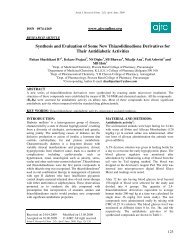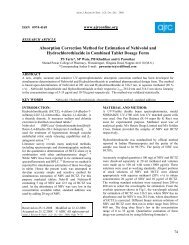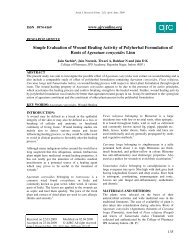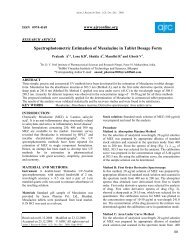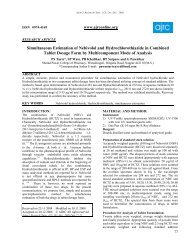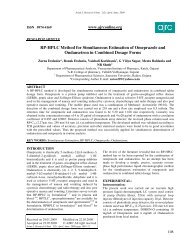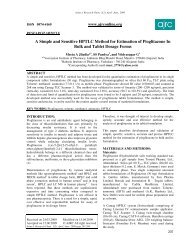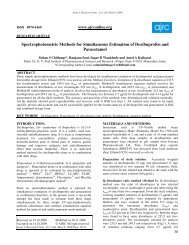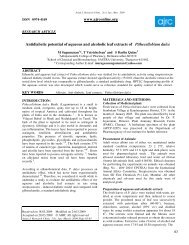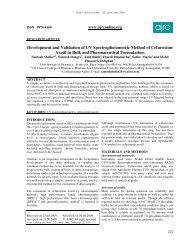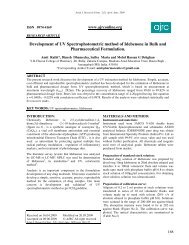Issue-4_April - Asian Journal of Research in Chemistry (AJRC)
Issue-4_April - Asian Journal of Research in Chemistry (AJRC)
Issue-4_April - Asian Journal of Research in Chemistry (AJRC)
You also want an ePaper? Increase the reach of your titles
YUMPU automatically turns print PDFs into web optimized ePapers that Google loves.
1. Department <strong>of</strong> pharmaceutical analysis, Anurag pharmacy college, Ananthagiri(V), Kodad(M), Nalgonda (Dt),<br />
Andhra Pradesh, India.508206<br />
2. D.C.R.M. Pharmacy College, Inkollu, Prakasham Dist, Andhra Pradesh, India.<br />
ABSTRACT:<br />
A simple, reproducible and efficient high performance liquid chromatographic method was developed for<br />
simultaneous determ<strong>in</strong>ation <strong>of</strong> Irbesartan and Hydrochlorothiazide <strong>in</strong> tablets. A Hypersil pack BDS C18 column<br />
250X4.6 mm 5µ particle size <strong>in</strong> isocratic mode with mobile phase conta<strong>in</strong><strong>in</strong>g acetonitrile: Buffer (sodium acetate<br />
anhydrous) (55:45 v/v ) adjusted to pH 3.5 us<strong>in</strong>g ortho phosphoric acid. The flow rate was 1.0 ml/m<strong>in</strong> and effluent<br />
was monitored at 260 nm. The retention time and l<strong>in</strong>earity range for Irbesartan and Hydrochlorothiazide were (2.98,<br />
4.83 m<strong>in</strong>) and (5-200, 1-400 g/ml), respectively. The developed method was found to be accurate, precise and<br />
selective for simultaneous determ<strong>in</strong>ation <strong>of</strong> Irbesartan and Hydrochlorothiazide <strong>in</strong> tablet dosage form.<br />
KEYWORDS: Irbesartan, Hydrochlorothiazide, RP-HPLC, simultaneous determ<strong>in</strong>ation, Validation.<br />
A M<strong>in</strong>uscule Study <strong>of</strong> Global Warm<strong>in</strong>g on Acetobacter aceti-Elevated Temperature and Its Impact over the<br />
Industries<br />
L. Krishnasamy and K. Jayanthi……………………………………………………………………………………………..477<br />
Dept. <strong>of</strong> Biotechnology, H<strong>in</strong>dustan College <strong>of</strong> arts and science, Kellambakkam-603 103, Chennai, Tamil Nadu<br />
ABSTRACT:<br />
The aim <strong>of</strong> this study was to <strong>in</strong>vestigate the effect elevated temperature on A.aceti which converts ethanol to acetic<br />
acid <strong>in</strong> the presence <strong>of</strong> oxygen. A.aceti was <strong>in</strong>cubated at various temperatures like 37°C, 42°C, and 47°C for<br />
overnight. After exposure, the DNA content <strong>in</strong> each culture was determ<strong>in</strong>ed. The results showed that an <strong>in</strong>crease <strong>in</strong><br />
temperature like 42°C and 47°C produced a marked decrease <strong>in</strong> the DNA content when compared to the culture<br />
<strong>in</strong>cubated at 37°C. The expression <strong>of</strong> gene was confirmed us<strong>in</strong>g PCR. The PCR result showed that the gene citrate<br />
synthase <strong>of</strong> A.aceti was expressed <strong>in</strong> the culture <strong>in</strong>cubated at 37°C and a significant suppression <strong>of</strong> the gene citrate<br />
synthase was seen <strong>in</strong> the culture treated at 42°C and 47°C.Therefore the elevated temperature on A.aceti will<br />
significantly affect the various importance <strong>of</strong> the organism especially <strong>in</strong> v<strong>in</strong>egar production where A.aceti plays a<br />
vital role.<br />
KEYWORDS: A.aceti, elevated temperature, v<strong>in</strong>egar, citrate synthase gene<br />
Solubility Enhancement <strong>of</strong> Poorly Water Soluble Drug by Solid Dispersion Technique<br />
Ahmed Samir 1 , Nagia El-Megrab 1 , Hanaa A. Fattah 1 , Waleed Barakat 2 ……………………………………………483<br />
Departments <strong>of</strong> 1 Pharmaceutics, 2 Pharmacology, Faculty <strong>of</strong> Pharmacy, Zagazig University, Egypt.<br />
ABSTRACT:<br />
The objective <strong>of</strong> present was to improve the solubility <strong>of</strong> Clonazepam (CZP), poorly water soluble drug, by solid<br />
dispersion technique us<strong>in</strong>g Polyethylene glycol 6000 (PEG 6000) and Urea (UR) as carriers. The Solid dispersion<br />
was prepared by physical mix<strong>in</strong>g and solvent evaporation method. The <strong>in</strong>teraction <strong>of</strong> the Clonazepam with PEG<br />
6000 and UR was evaluated by the Fourier transform <strong>in</strong>frared (FTIR) spectroscopy; Differential scann<strong>in</strong>g<br />
Calorimetry (DSC) and X-ray diffraction patterns (XRD). The results from the FTIR and XRD analyses showed that<br />
Solid dispersion might exist <strong>in</strong> the amorphous form. A DSC result showed that the sharp melt<strong>in</strong>g po<strong>in</strong>t was<br />
completely disappeared suggest<strong>in</strong>g that the CZP molecularly dispersed <strong>in</strong> an amorphous form. Dissolution studies<br />
<strong>in</strong>dicate that dissolution rate was remarkably <strong>in</strong>creased <strong>in</strong> Solid dispersion as compared to the physical mixture and<br />
drug alone. Also the pharmacological studies <strong>of</strong> the selected formulations [(1:3 CZP : PEG 6000) and (1:2 CZP :<br />
Urea)] were performed. In conclusion PEG 6000 and UR can be a well utilized to <strong>in</strong>crease the solubility <strong>of</strong> poorly<br />
water soluble drugs.<br />
KEY WORDS: Clonazepam, solid dispersion, Polyethylene glycol 6000, Urea.





